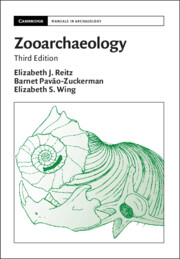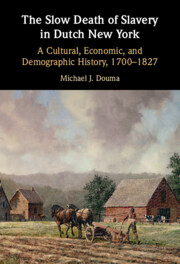Refine search
Actions for selected content:
262 results

Zooarchaeology
- Coming soon
-
- Expected online publication date:
- December 2025
- Print publication:
- 18 December 2025
-
- Textbook
- Export citation
The Church, Politics, and Demography in Late Imperial Russia
-
- Journal:
- Slavic Review , First View
- Published online by Cambridge University Press:
- 14 November 2025, pp. 1-18
-
- Article
-
- You have access
- Open access
- HTML
- Export citation
3 - Interventionist Population Policies of the 1950s
-
- Book:
- Population Control as a Human Right
- Published online:
- 09 October 2025
- Print publication:
- 23 October 2025, pp 32-54
-
- Chapter
- Export citation
Local Responses to a Fourteenth-Century AD Immigration Event on the Georgia Coast
-
- Journal:
- American Antiquity , First View
- Published online by Cambridge University Press:
- 02 September 2025, pp. 1-22
-
- Article
-
- You have access
- Open access
- HTML
- Export citation
Some intergenerational arithmetic to control public debt in the EU
-
- Journal:
- Journal of Pension Economics & Finance , First View
- Published online by Cambridge University Press:
- 27 August 2025, pp. 1-18
-
- Article
-
- You have access
- Open access
- HTML
- Export citation
Chapter 1 - Depopulation, Debt, and Distrust
-
- Book:
- Time and Governance in Fifteenth-Century Perpignan
- Published online:
- 26 July 2025
- Print publication:
- 14 August 2025, pp 11-38
-
- Chapter
- Export citation
Amazonian forest conservation through sustainable use: evidence based on Brazil nut life histories linked to human occupation
-
- Journal:
- Environmental Conservation / Volume 52 / Issue 3 / September 2025
- Published online by Cambridge University Press:
- 24 July 2025, pp. 98-107
-
- Article
- Export citation
Chapter 2 - Neurorespiratory Medicine
-
-
- Book:
- Clinical Neurorespiratory Medicine
- Published online:
- 26 May 2025
- Print publication:
- 19 June 2025, pp 19-22
-
- Chapter
- Export citation
Introduction - People, Place, Identity
-
- Book:
- Berlin
- Published online:
- 13 February 2025
- Print publication:
- 30 January 2025, pp 1-8
-
- Chapter
- Export citation
Perceived threat and demographic misperception
-
- Journal:
- Politics and Religion / Volume 18 / Issue 1 / March 2025
- Published online by Cambridge University Press:
- 24 January 2025, pp. 149-162
-
- Article
-
- You have access
- Open access
- HTML
- Export citation
Chapter 5 - Sold South?
-
- Book:
- The Slow Death of Slavery in Dutch New York
- Published online:
- 20 December 2024
- Print publication:
- 09 January 2025, pp 140-173
-
- Chapter
- Export citation
The age-productivity profile: long-run evidence from Italian regions
-
- Journal:
- Journal of Demographic Economics / Volume 91 / Issue 4 / December 2025
- Published online by Cambridge University Press:
- 23 December 2024, pp. 641-662
-
- Article
- Export citation

The Slow Death of Slavery in Dutch New York
- A Cultural, Economic, and Demographic History, 1700–1827
-
- Published online:
- 20 December 2024
- Print publication:
- 09 January 2025
4 - Reproduction and Male Social Relationships
-
- Book:
- Elephants
- Published online:
- 12 December 2024
- Print publication:
- 19 December 2024, pp 66-100
-
- Chapter
- Export citation
1 - Kurdistan
-
- Book:
- The Political Ecology of Violence
- Published online:
- 22 November 2024
- Print publication:
- 05 December 2024, pp 36-90
-
- Chapter
- Export citation
3 - The Diversity of Longevity Metrics
-
-
- Book:
- The Biodemography of Ageing and Longevity
- Published online:
- 14 November 2024
- Print publication:
- 21 November 2024, pp 28-47
-
- Chapter
- Export citation
12 - Longevity in Modern Populations
-
-
- Book:
- The Biodemography of Ageing and Longevity
- Published online:
- 14 November 2024
- Print publication:
- 21 November 2024, pp 239-252
-
- Chapter
- Export citation
1 - A Bird’s-Eye View of Gaza’s Economy, Population, and Geostrategic Position
-
- Book:
- Late Ottoman Gaza
- Published online:
- 07 November 2024
- Print publication:
- 21 November 2024, pp 34-64
-
- Chapter
- Export citation
The Role of Sibling Patterns in the Educational Attainment of Hungarian Twins
-
- Journal:
- Twin Research and Human Genetics / Volume 27 / Issue 4-5 / August 2024
- Published online by Cambridge University Press:
- 11 November 2024, pp. 231-240
-
- Article
-
- You have access
- Open access
- HTML
- Export citation
Demography, habitat use, and movement patterns of founder Oriental Storks Ciconia boyciana in South Korea
-
- Journal:
- Bird Conservation International / Volume 34 / 2024
- Published online by Cambridge University Press:
- 31 October 2024, e30
-
- Article
-
- You have access
- Open access
- HTML
- Export citation
